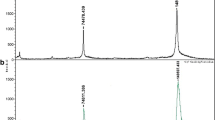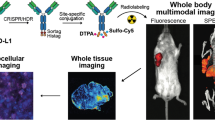Abstract
Purpose
The tyrosine kinase receptor Axl is overexpressed in various types of cancer and correlated with cancer malignancy. Selective Axl blockade reduces tumor growth and metastasis. The purpose of this study was to examine whether the humanized anti-Axl antibody humanized 173 (h173) labeled with near-infrared fluorescence (NIRF) dye Cy5.5 could be applied as a molecular imaging probe for NIRF imaging of Axl expression in tumor models.
Procedures
NIRF dye Cy5.5 was conjugated to h173 or human normal immunoglobulin G (hIgG) control through amino groups. The resulting probes were evaluated in both A549 (Axl positive) and NCI-H249 (Axl negative) lung cancer xenografts through in vivo NIRF imaging. Ex vivo imaging and probe distribution assay were also carried out to confirm the in vivo imaging results.
Results
After conjugation, binding activity of h173-Cy5.5 was determined to be 97.75 % ± 2.09 % of the unmodified h173. In vitro fluorescence-activated cell sorting (FACS) and fluorescence microscopy analysis validated the specific binding of h173 toward Axl-positive A549 cells. h173-Cy5.5 was then applied to image Axl expression in vivo. In A549 (Axl positive) cancer xenografts, the tumor uptake of h173-Cy5.5 was significantly higher than that of the hIgG-Cy5.5 control (P < 0.05) at late time points (1, 2, 3, 4, and 7 days). On the contrary, in NCI-H249 (Axl negative) cancer xenografts, the tumor uptake of both hIgG-Cy5.5 and h173-Cy5.5 was low and showed no significant difference (P > 0.05) at all time points examined. Ex vivo imaging and immunofluorescence staining analysis further validated the in vivo imaging results.
Conclusions
Collectively, all in vitro, in vivo, and ex vivo data suggested that h173-Cy5.5 could serve as a valid probe for Axl-targeted cancer imaging, which could therefore aid in tumor diagnosis, prognosis, and treatment monitoring.





Similar content being viewed by others
References
Liu E, Hjelle B, Bishop JM (1988) Transforming genes in chronic myelogenous leukemia. Proc Natl Acad Sci U S A 85:1952–1956
Janssen JW, Schulz AS, Steenvoorden AC et al (1991) A novel putative tyrosine kinase receptor with oncogenic potential. Oncogene 6:2113–2120
Stitt TN, Conn G, Gore M et al (1995) The anticoagulation factor protein S and its relative, Gas6, are ligands for the Tyro 3/Axl family of receptor tyrosine kinases. Cell 80:661–670
Varnum BC, Young C, Elliott G et al (1995) Axl receptor tyrosine kinase stimulated by the vitamin K-dependent protein encoded by growth-arrest-specific gene 6. Nature 373:623–626
Linger RM, Keating AK, Earp HS, Graham DK (2008) TAM receptor tyrosine kinases: biologic functions, signaling, and potential therapeutic targeting in human cancer. Adv Cancer Res 100:35–83
Craven RJ, Xu LH, Weiner TM et al (1995) Receptor tyrosine kinases expressed in metastatic colon cancer. Int J Cancer 60:791–797
Nemoto T, Ohashi K, Akashi T et al (1997) Overexpression of protein tyrosine kinases in human esophageal cancer. Pathobiology 65:195–203
Tsou AP, Wu KM, Tsen TY et al (1998) Parallel hybridization analysis of multiple protein kinase genes: identification of gene expression patterns characteristic of human hepatocellular carcinoma. Genomics 50:331–340
Ito T, Ito M, Naito S et al (1999) Expression of the Axl receptor tyrosine kinase in human thyroid carcinoma. Thyroid 9:563–567
Meric F, Lee WP, Sahin A et al (2002) Expression profile of tyrosine kinases in breast cancer. Clin Cancer Res 8:361–367
Sun W, Fujimoto J, Tamaya T (2004) Coexpression of Gas6/Axl in human ovarian cancers. Oncology 66:450–457
Shieh YS, Lai CY, Kao YR et al (2005) Expression of Axl in lung adenocarcinoma and correlation with tumor progression. Neoplasia 7:1058–1064
Wimmel A, Glitz D, Kraus A et al (2001) Axl receptor tyrosine kinase expression in human lung cancer cell lines correlates with cellular adhesion. Eur J Cancer 37:2264–2274
Vajkoczy P, Knyazev P, Kunkel A et al (2006) Dominant-negative inhibition of the Axl receptor tyrosine kinase suppresses brain tumor cell growth and invasion and prolongs survival. Proc Natl Acad Sci U S A 103:5799–5804
Nakano T, Tani M, Ishibashi Y et al (2003) Biological properties and gene expression associated with metastatic potential of human osteosarcoma. Clin Exp Metastasis 20:665–674
Liu R, Gong M, Li X et al (2010) Induction, regulation, and biologic function of Axl receptor tyrosine kinase in Kaposi sarcoma. Blood 116:297–305
Lay JD, Hong CC, Huang JS et al (2007) Sulfasalazine suppresses drug resistance and invasiveness of lung adenocarcinoma cells expressing AXL. Cancer Res 67:3878–3887
Zhang Z, Lee JC, Lin L et al (2012) Activation of the AXL kinase causes resistance to EGFR-targeted therapy in lung cancer. Nat Genet 44:852–860
Li Y, Ye X, Tan C et al (2009) Axl as a potential therapeutic target in cancer: role of Axl in tumor growth, metastasis and angiogenesis. Oncogene 28:3442–3455
Holland SJ, Pan A, Franci C et al (2010) R428, a selective small molecule inhibitor of Axl kinase, blocks tumor spread and prolongs survival in models of metastatic breast cancer. Cancer Res 70:1544–1554
Li D, Liu S, Liu R et al (2013) Targeting the EphB4 receptor for cancer diagnosis and therapy monitoring. Mol Pharm 10:329–336
Li D, Liu S, Liu R et al (2013) EphB4-targeted imaging with antibody h131, h131-F(ab')2 and h131-Fab. Mol Pharm 10:4527–4533
Liu S, Li D, Park R et al (2013) PET imaging of colorectal and breast cancer by targeting EphB4 receptor with 64Cu-labeled hAb47 and hAb131 antibodies. J Nucl Med 54:1094–1100
Zhang B, Shan H, Li D et al (2012) Different methods of detaching adherent cells significantly affect the detection of TRAIL receptors. Tumori 98:800–803
Verma A, Warner SL, Vankayalapati H et al (2011) Targeting Axl and Mer kinases in cancer. Mol Cancer Ther 10:1763–1773
Roopenian DC, Akilesh S (2007) FcRn: the neonatal Fc receptor comes of age. Nat Rev Immunol 7:715–725
Song H, Sgouros G (2011) Radioimmunotherapy of solid tumors: searching for the right target. Curr Drug Deliv 8:26–44
Cardoso MM, Peca IN, Roque AC (2012) Antibody-conjugated nanoparticles for therapeutic applications. Curr Med Chem 19:3103–3127
Madhumathi J, Verma RS (2012) Therapeutic targets and recent advances in protein immunotoxins. Curr Opin Microbiol 15:300–309
Holliger P, Hudson PJ (2005) Engineered antibody fragments and the rise of single domains. Nat Biotechnol 23:1126–1136
Xie J, Chen K, Huang J et al (2010) PET/NIRF/MRI triple functional iron oxide nanoparticles. Biomaterials 31:3016–3022
Liu S, Li D, Huang CW et al (2012) Efficient construction of PET/fluorescence probe based on sarcophagine cage: an opportunity to integrate diagnosis with treatment. Mol Imaging Biol 14:718–724
Hutterer M, Knyazev P, Abate A et al (2008) Axl and growth arrest-specific gene 6 are frequently overexpressed in human gliomas and predict poor prognosis in patients with glioblastoma multiforme. Clin Cancer Res 14:130–138
Sensi M, Catani M, Castellano G et al (2011) Human cutaneous melanomas lacking MITF and melanocyte differentiation antigens express a functional Axl receptor kinase. J Invest Dermatol 131:2448–2457
Acknowledgments
This work was supported by the NIBIB (R21 1 r21 eb012294-01a1), Early (Margaret E.) Medical Research Trust, the American Cancer Society (121991-MRSG-12-034-01-CCE), SC CTSI (12-2176-3135), Department of Defense (BC102678), Vasgene Therapeutics Inc. (NIH: CA168158-01; CA171538-01), National Natural Science Foundation of China (No. U1032002, 81071206, 81271621, 81301266), and Key Clinical Research Project of Public Health Ministry of China 2010-2012 (No. 164).
Conflict of Interest
The authors declare the following competing financial interest(s): K.N. is the employee of Vasgene Therapeutics Inc.
Author information
Authors and Affiliations
Corresponding authors
Rights and permissions
About this article
Cite this article
Li, D., Liu, S., Liu, R. et al. Axl-Targeted Cancer Imaging with Humanized Antibody h173. Mol Imaging Biol 16, 511–518 (2014). https://doi.org/10.1007/s11307-013-0714-z
Published:
Issue Date:
DOI: https://doi.org/10.1007/s11307-013-0714-z




